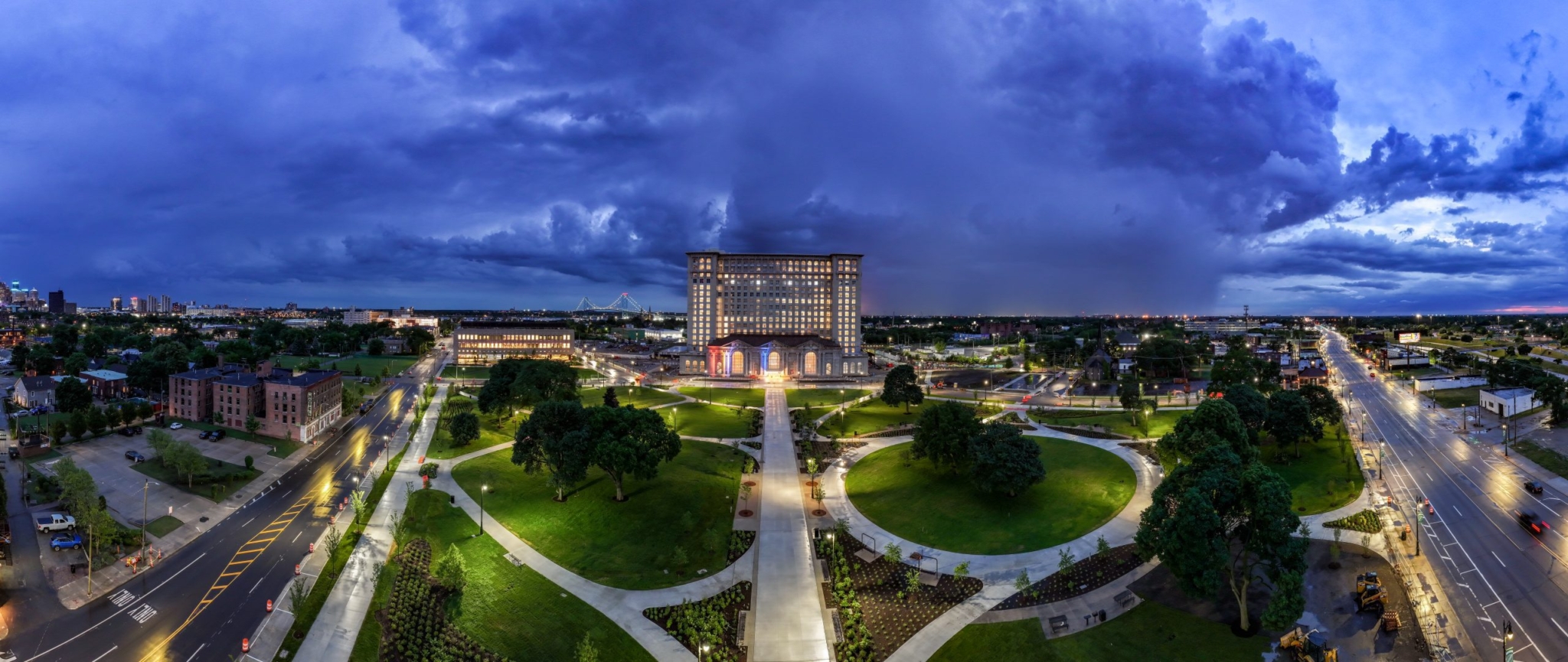
Long a living symbol of Detroit’s 20th century decline, the restored station is aiming to play a key role in the Motor City’s 21st century rebirth.
The last time I heard a train conductor bellow “all aboard” was at the opulent Michigan Central Station in Detroit in 1968.
As a well-traveled 12-year-old, I was always overwhelmed by the sheer size of the Beaux-Arts building. Its classical façade and chandelier-clad lobby provided me with my first taste of architectural art and design.
And I was there a lot. I was fortunate to grow up in East Detroit, just a long Jared Goff pass north of the infamous 8 Mile Road that separates the city from its northern suburban bedroom communities. My mother passed away when I was just 4, and my father, who was mayor of East Detroit and chairman of the Macomb County Supervisors, would take me along on nearly every trip to cities hosting conventions and conferences across the United States.
We almost always traveled by train. New York, Washington, D.C., Chicago, New Orleans and even Los Angeles were the destinations that provided so many wonderful memories for a father and son team.
And we always returned home to the glorious Michigan Central Station. It was welcoming in all its splendor. I did not imagine that this grand dame of Detroit would be shuttered in 1988, giving way to increased travel by air or automobile.
In the 36 years since its closing, Michigan Central Station became a symbol of all the things that were wrong with Detroit. Vandals and squatters destroyed the abandoned building’s aesthetics, breaking most of its windows, flooding the basement, ripping up tiles and covering its walls with graffiti. Laying dormant and in ruins, it seemed Michigan Central Station had an eventual destiny with the wrecking ball.
That is when Ford stepped in with a better idea. Bill Ford, specifically.
The great-grandson of automobile pioneer Henry Ford and the current executive chairman of Ford Motor Company, Bill Ford announced in 2018 that the blighted Michigan Central Station was one Detroit asset that would not be liquidated. Under Bill Ford’s direction, the Ford Motor Company purchased the dilapidated building for $90 million from the city’s wealthy Moroun family.
Shortly after buying the building, Ford began a project of replacing and repairing the 102,000 square-feet of windows in the 18-story structure. That window work was soon followed by a nearly $1 billion investment to restore the station to its former glory.

Thursday marks the official grand reopening of the rescued Michigan Central Station. Motown will celebrate this return to glory in many of the same ways Detroit has marked its dance card comeback with the resurgent Detroit Lions, the NFL Draft, the Detroit Grand Prix, and the Riverfront music festivals.
A 90-minute concert will be held in front of the station, produced by Eminem and featuring Detroit natives Diana Ross, Jack White, and Big Sean. These home-grown musical talents will be joined onstage by Jelly Roll, Common, Melissa Ethridge, Fantasia, and the Detroit Symphony Orchestra, along with possible special guests.
The sold-out concert will be available to stream live on NBC’s Peacock at 8:30 p.m. Eastern time, and a one-hour show of “Live From Detroit: The Concert at Michigan Central” will be broadcast Sunday night on NBC at 7 p.m. Eastern.
While I feel proud that my city is restoring this historic gem, I am also a bit saddened by memories that cannot be relived.
Since Michigan Central Station will no longer be a working train depot, my boyhood locomotive innocence will just have to remain a memory. The smell of cigar smoke mingling with the scent of popcorn will not return to the concourse where passengers once waited to board. And stepping outside to the platform conjures up memories of the stinging of my olfactory senses as I breathed in the air that tasted of diesel and creosote-coated railroad ties.
Yet, Ford and the team who worked on the Michigan Central restoration have breathed new life into the palatial building.
To repair the outside of the building, Ford and its partners sourced six hundred tons of limestone from the same quarry in Indiana that provided the original stone for the station’s exterior more than one hundred years ago. The Dark Hollow Quarry, located about thirty-five miles south of Bloomington, had been closed for three decades and was re-opened for the project. A Michigan carver mason spent 428 hours hand-carving a replica of a single column capital from one of the limestone blocks for the building’s north entrance.
More than 4,000 new light fixtures were installed including re-creations of three massive chandeliers in the Waiting Room and Grand Hall. Restoring the buildings stunning Waiting Room and Grand Hall required the equivalent of 8.7 miles of grout used on the 29,000 Guastavino ceiling tiles. All but 1,300 of these tiles are original to the station.
Cleanup required 3.5 million gallons of water being pumped from the basement. Nearly 4,000 cubic yards of debris was hauled out of the building.
The architectural arts firm EverGreene was retained by Ford to assess, replicate, and restore approximately 56,000 square feet of decorative interior plasterwork which covers the building’s first floor. EverGreene preserved and cleaned the original plaster material that could be saved and fabricated new portions where needed. A team of 20 craftspeople did the plasterwork by hand including the replication of more than 3,000 cast plaster pieces including the coffers, medallions and rosettes that adorn the waiting room’s walls and ceiling.
In all, more than 3,100 workers spent about 1.7 million hours of labor on the station and its surrounding public spaces.
Michigan Central Station is the centerpiece of a 30-acre campus with space for restaurants, retail, and other community partners. Right next door to the station is Newlab, which in just more than a year since its launch, has grown to more than six hundred employees from nearly 100 companies and startups. Newlab at Michigan Central provides a state-of-the-art testing environment and includes infrastructure like the first electrified public road where electric vehicles can be charged while driving over the road.

Ford is among the renovated building’s first tenants and will move employees from its Ford Model e and Ford Integrated Services team into three floors of office space in the coming months. Approximately 1,000 Ford employees will work across the Michigan Central campus by the end of the year, with a goal of 2,500 by 2028.
Michigan Central Station was originally designed by architectural firms Warren & Wetmore and Reed & Stem, the same teams who collaborated on New York’s famous Grand Central Station. Michigan Central Station opened only 11 months after the debut of Grand Central Station.
The reopening of Michigan Central Station is evidence that Detroit is enjoying a resurgence as a beacon of America’s innovation and manufacturing technology. Detroit had 1.8 million residents in the 1950s, many of whom were attracted to well-paying manufacturing jobs which were created when Henry Ford began paying his workers $5 a day, a revolutionary sum in 1914. Many of the people who migrated to the Motor City were from economically challenged southern states and passed through Michigan Central on their final stop to hope and prosperity.
Michigan Central Station first opened for train travel in 1913 and attracted more than 4,000 passengers daily during its peak in the 1940s and 1950s.
The screeching of train wheels on the rails may not be heard at Michigan Central these days, but the building’s restoration reaffirms Detroit’s continued commitment to manufacturing, mobility technology and all the innovation yet to come.
